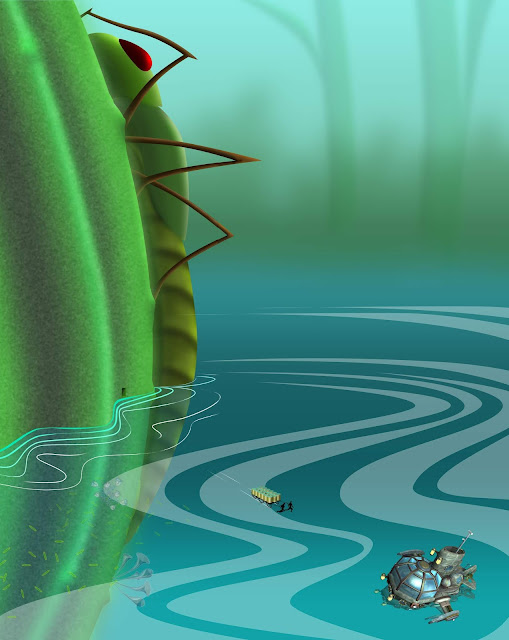The Age of Discovery, Chapter 11: Run!
Day 8: 1730 hours...
Seeing Barron Wolf’s hulking
silhouette standing before us back on the upper level is a welcome sight. The big man wraps his huge arms around
Lyra and I simultaneously.
We eagerly exchange tales: Lyra and
I, the remarkable story of our trip down through the plant, of the amazing
discovery of the already-harvested diatom oil, all that we would need, packaged
and ready for us to transport.
Barron regales us with his thrilling account of the tidal wave, and that
of the rush-climbing aquatic insect, which continues to cover the doorway, our
only means of escaping the plant’s interior.
“The wave probably disturbed that
insect,” Lyra explains. “So it
came looking for a new resting place.”
“And found one right in front of
our door!” bellows a frustrated Barron.
“How are we supposed to get out of this rush?”
“I don’t think she will be here much longer,” muses Lyra
confidently. “This is the nymph
stage of Ceratopogonidae Leptoconops, known
commonly as no-see-ums. I’m sure it will be moving on as soon as
it warms itself in the sunlight.”
“That
thing is a no-see-um?” asks an incredulous Barron. “They used to drive me nuts when I was growing up in
Minnesota. Darn things would get
in my ears and nose whenever we went fishing… but those were practically too
small to see.”
Barron’s
recollection is a sobering reminder that the warming day will bring other
aquatic insects to the surface, and they will be hungry. “Let’s just hope Lyra is right, and
this one will soon be moving along.
In the mean time, let’s get that diatom oil moved up here!”
In
the end, the process of hoisting the diatom oil canisters up the vallecular
canal to the upper platform takes two more trips using Barron’s hemp rope
elevator system. Lyra, Barron, and
I work quickly, buoyed by a warm afternoon light that fills the chamber with a
reassuring glow.
We
are transferring the final load from the lift when the door-blocking insect begins
respiring rapidly. Heat radiates
from its body. Through its
translucent abdominal wall, illuminated from behind by the sun, we can see an
arterial network swelling with circulatory fluid. With a sudden rasping of its barbed legs, the insect is
gone.
Our
door to the outside is no longer blocked!
Unfiltered light streams in.
Visible through that rectangular portal, Cyclops is resting on her keel across a short expanse of glassy
impenetrable water – and what a joy it is to see her undamaged!
Lyra
contemplates aloud what I am already thinking: “We need an easy way to get the
oil over to the ship.”
“I’ve
already worked out a solution for that,” declares Barron. “You see, while you were down inside
that plant I was actually getting something done.”
From
the chiseled–out hallway Barron reveals a plank-like sledge, evidently made
from a cellulose lath he has scavenged from the upper platform. “Now if we only had a microscopic mule
team,” he adds.
“Our
own strong backs will have to suffice,” I say, and begin fashioning a simple
harness and towline. “Besides, the
exercise will be good for us.” Neither Lyra nor Barron offer any response beyond a couple of
quiet grunts.
With
ourselves as beasts-o-burden, we begin dragging the oil across the solid plain,
from the rush to the ship. Glide
runners fashioned from Barron’s ingenious use of two S-shaped micro fibers
provide near frictionless contact between the sledge and the aquatic
interface. Once set in motion, the
loaded sledge slides easily, as if over a smooth frozen lake in a Vermont January.
As
we approach Cyclops, Gyro runs out to
greet us and assist with the labor.
The young steersman is evidently eager to reunite with the crew. He gives his own colorful account of
his exciting ride on the tidal wave.
With his help we are soon alongside our sturdy ship, unloading the oil
canisters from the sledge.
“The
oil will serve perfectly as a surfactant,” explains Barron, “That is, it will
break the surface tension between the water and the air, or in this case, the
water and the ship.”
“I
just have one question,” says Gyro.
“To get the ship back beneath the surface do we apply the oil to the
water around the ship, or do we pour it over the hull?”
“Neither,” Barron answers
confidently. “To insure the best coverage and most effective use of the oil, we
will atomize it – turn it into an aerosol.”
“Barron, do we have the equipment
for that?” I ask, already guessing the answer.
“The main propeller will serve as a
distributor,” explains Barron with a prideful tone – my engine master is evidently
pleased with his solution for oil distribution. “With the engine in reverse, the prop will throw the oil
into a mist, effectively coating both the ship and the water beneath it. That’s
all it will take. Cyclops will slip beneath the surface
and we will back in business.”
From the glassy surface around us,
pupae continue to surface, and hungry adult insects emerge. I am relieved to
hear that Barron had worked out a fast way to distribute the oil and that we will
soon be underway.
Then chaos.
“Run!” shouts someone, although now
I’m unable to recall who it was. A shadow passes over the sun, shading the
stranded Cyclops and an area several
millimeters around it. Looking back over my shoulder the sky disappears,
replaced by massive compound eyes, dagger-like mandibles, and the slathering
mouth of a monster.
It is our friend the no-see-um, and she is hungry.



Comments
Post a Comment